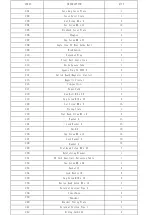
5
5. STAND TO THE SIDE WHEN FEEDING
MATERIAL.
Never stand or have any part of your body in line
with the path of the saw blade;
6. USE
CAUTION
WHEN
REACHING
FOR
OBJECTS.
Never reach behind or over the cutting tool with
either hand for any reason;
7. SAFE CROSSCUTTING OPERATIONS.
Move the rip fence out of the way when
crosscutting;
8. ENSURE CORRECT FEEDING OF MATERIAL.
Feed the work into the blade against the direction
of rotation;
9. CORRECT USAGE WITH THE FENCE.
Never use the fence as a cut-off gauge when you
are cross-cutting;
10. ALWAYS TURN THE POWER TO THE "OFF"
POSITION.
When attempting to free a stalled saw blade,
always turn the saw to the "off" position;
11. PROVIDE ADEQUATE SUPPORT.
To the rear and sides of the table saw for wide or
long work pieces;
12. AVOID KICKBACKS.
Avoid kickbacks (work thrown back towards you)
by keeping the blade sharp, by keeping the rip
fence parallel to the saw blade, by keeping the
splitter and guard in place and operating, by not
releasing work before it is pushed all the way past
the saw blade, and by not ripping work that is
twisted or warped or does not have a straight edge
to guide along the fence;
13. AVOID AWKWARD OPERATIONS.
Avoid awkward operations and hand positions
where a sudden slip could cause your hand to
move into the spinning blade;
14. CORRECT SAW BLADE USAGE.
No saw blade shall be used where the maximum
marked speed is lower than the maximum
rotational speed of the saw spindle;
15. CHIP AND DUST.
The machine shall be connected to an external
chip and dust extraction system;
The dust extraction equipment is to be switched on
before commencing machining;
16. CHECK
Periodically check stop time of blade to make sure
the completed stop time of the saw blade is less
than 10 seconds.
2.3 Residual Risks
1.
Take precautions to reduce the hazard of
inhalation of harmful dust (e.g. wearing a dust
mask);
2.
Wear ear protection to prevent hearing loss;
3.
Always wear safety glasses. Also, use a face
or dusk mask if the cutting operation is dusty;
4.
Protect against the hazard of being cut when
handling saw blades in the machine or while
performing maintenance on the machine;
5.
Do NOT try to remove chips while the saw is
running or the saw blade is moving;
6.
Do NOT use the machine unless all of the
guards and other safety devices necessary for
the particular operation are in good working
order and in place.
2.4 Safety Equipment
When cutting narrow workpieces, a Push Block
must be used. Push the work piece against the
fence if necessary. A push block can be easily
made by the operator as shown in
Fig. 2
.
If the workpieces is less then 4-3/4” (120 mm), you
must use the push stick, as shown in Fig.3, to
prevent your hands from getting too close to the
saw blade.
Fig. 2
Fig. 3







































